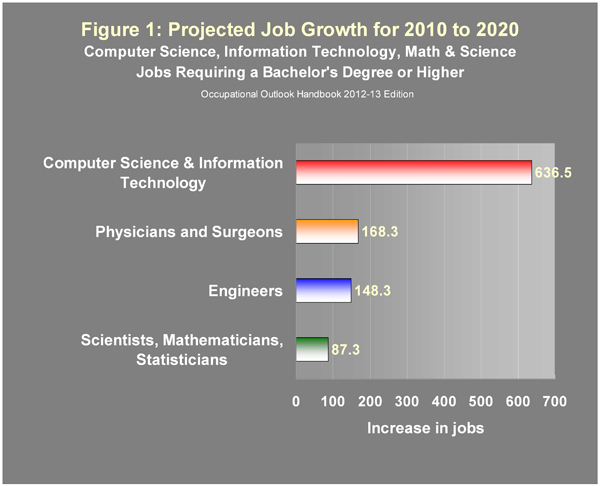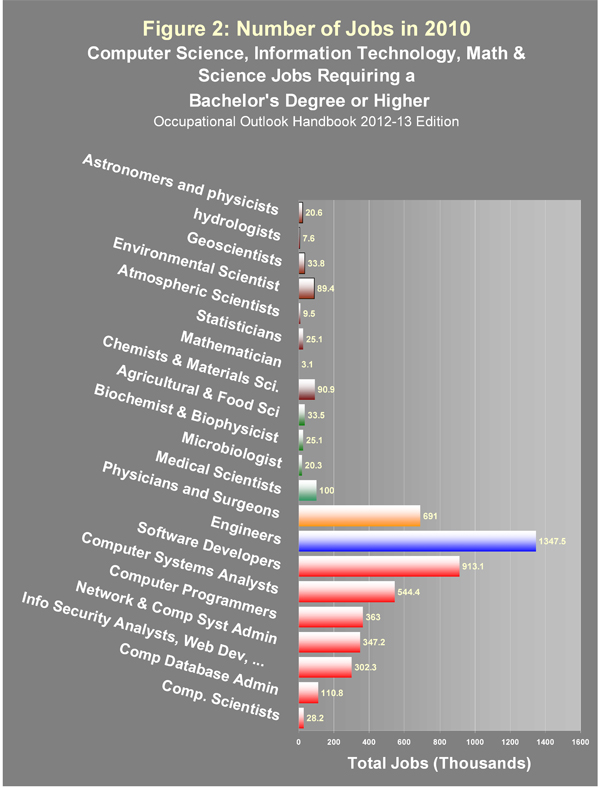- Myths About The Computer Science (CS) and
- Information Technology (IT) Job Market
- Why we need to prepare more students for success in computer science fields
Myths
► Myth 1: There are no jobs
Fact: Add up all the expected growth in scientist (all areas) mathematician, statistician, engineering, physician, and surgeon jobs in America and the expected growth in computer science (CS) and information technology (IT) jobs requiring a bachelor's degree or higher exceeds it by about 57% (see Figure 1).
Fact: Add up all the existing scientist (all areas) mathematician, statistician, engineering, physician, and surgeon jobs in America and the CS and IT jobs requiring a bachelor's degree or higher is comparable to the total (see Figure 2).
► Myth 2: All CS and IT jobs require a four year computer science degree or higher.
Fact: While some college is usually needed, the Occupational Outlook Handbook reports there are over 600,000 computer support specialist jobs that don't require a degree.
Fact: Numerous certification programs other than traditional degree programs are also available to help provide training and credentials for motivated individuals.
► Myth 3: The IT and CS field is only about various forms of computer programming.
Fact: The IT and CS field goes far beyond computer programming. It's about creating systems to collect, store, analyze, communication, and use humanity's information from all areas, including art, music, social interaction, commerce, medicine, etc. Computer programming is no more the ultimate purpose of the IT and CS field than telescope viewing is the ultimate purpose of astronomy (see CS Unplugged).
► Myth 4: There are no outstanding entrepreneur opportunities such as Facebook, Google, Amazon.com, or Microsoft left in CS and IT.
Fact: Existing technologies continue to evolve and new technologies, such as smart phones, continue to appear at an incredible rate. There is no way to predict what the next billion dollar opportunity will be, but a next one is highly probable.
Links
Robert Half Technology: a leading provider of IT professionals on a project and full-time basis. The site provides a wealth of information about the IT job market including a part that calculates salaries in your local job market.
Computer Science Teachers Association (CSTA): The Voice for K-12 computer science education and its educators.
Mr. Rogers' AP Computer Science Syllabus: This page was created and is maintained by Mr. Rogers for his AP and IB Computer Science classes. You can contact him at tkrogers@greenville.k12.sc.us
Education Policy Committee, Association for Computing Machinery

Reference: Occupational Outlook Handbook (OOH), 2012-13 Edition

- Notes:
The above plots include most if not all of the jobs typically associated with science, technology, engineering, and math (STEM) disciplines. It has omitted STEM related education careers and social science jobs in areas such as psychology, anthropology, sociology, etc.
- Since the job market is constantly changing and evolving, the Occupational Outlook Handbook is not entirely consistent in how they list job categories. This accounts for some of the differences from year to year in the plots provided on this web site. To make matters worse, the CS and IT job markets are at times almost like the wild west. Differing from STEM professionals that have well defined licensing and education requirements, such as engineers and physicians, many CS and IT professionals have degrees in non-computer areas. In fact, some of the top professionals have no degrees. However, as the area grows and matures, having a college degree will become increasingly important, hence, only jobs listed in the Occupational Outlook Handbook as requiring a bachelor's degree or higher have been included in the above figures.
The engineering item in the above figures includes aerospace, biomedical, chemical, civil, computer, electrical, environmental, health and safety, industrial, materials, mechanical, nuclear, and petroleum engineers--by far the bulk of those occupations that could be rightfully considered engineering. Some of the categories listed in the Occupational Outlook Handbook under the Architecture and Engineering Occupations heading such as all forms of architects, agricultural engineers, and all forms of technicians have been omitted because they would not have the same type of educational and licensing requirements as the traditional form of engineering professions.